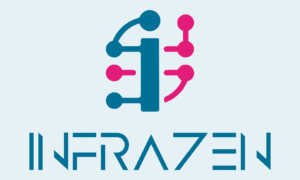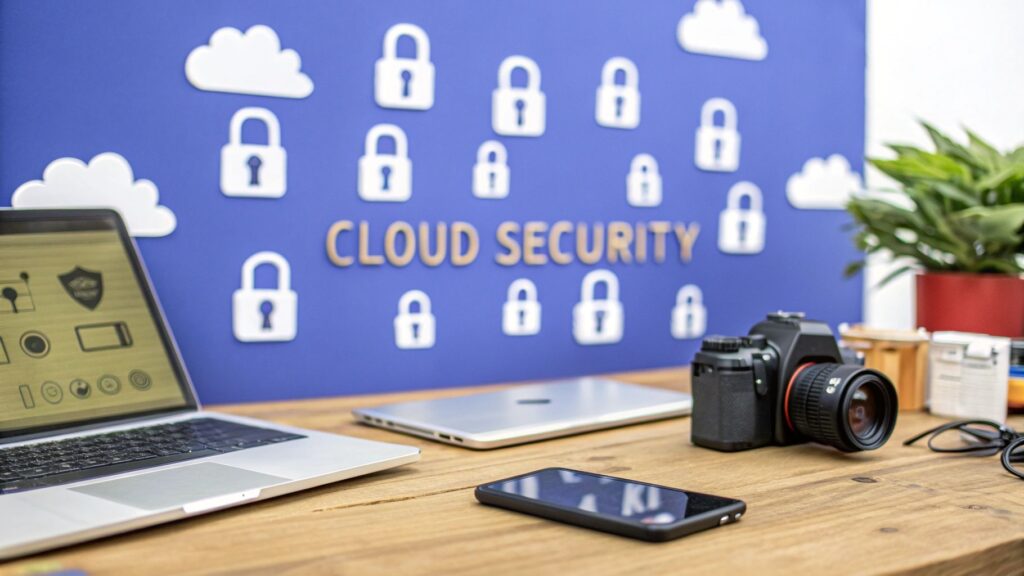In the UK's bustling creative sector, your ideas, client work, and digital assets are your most valuable currency. You rely on cloud platforms like Adobe Creative Cloud, Google Workspace, and Dropbox to collaborate and bring visions to life. But with this convenience comes a critical responsibility: securing that data. A single security lapse could lead to project delays, severe reputational damage, and a complete loss of client trust.
This guide moves beyond generic IT jargon. It is a focused, practical breakdown of cloud security best practices tailored specifically for the operational realities of creative freelancers, studios, and marketing agencies in the UK. We recognise that your primary focus is on delivering exceptional creative work, not becoming a cybersecurity expert. Therefore, we will provide clear, actionable strategies to protect your intellectual property and sensitive client information, ensuring your cloud technology remains a powerful enabler for your creativity, not a vulnerability.
You will learn how to implement robust security measures that are both effective and manageable for a creative team. We will cover essential topics, including:
- Adopting a Zero Trust security model.
- Enforcing strong Multi-Factor Authentication (MFA).
- Implementing data encryption for files in transit and at rest.
- Mastering Identity and Access Management (IAM).
- Conducting regular security audits and planning for disaster recovery.
By following these structured guidelines, you can build a secure foundation for your creative operations, protecting your business and your clients from digital threats.
1. Embrace the 'Never Trust, Always Verify' Rule: Zero Trust Architecture
Think of your digital workspace like an exclusive art gallery. You would not let just anyone wander in and touch the exhibits. A Zero Trust approach applies this same principle to your cloud environment. It discards the outdated idea that everything inside your network is safe. Instead, it meticulously checks every single request to access data, whether it is a designer in your London studio opening a project file or a freelance collaborator logging in from Manchester. This means verifying identity and permissions every time, for everyone.
For creative agencies handling sensitive client assets, this is not paranoia; it is professional diligence. Implementing this is a cornerstone of modern cloud security best practices, ensuring that only the right people can access the right files at the right time. This greatly reduces the risk of your valuable intellectual property falling into the wrong hands.
How to Implement a Zero Trust Model
Adopting a Zero Trust framework does not happen overnight. It is a strategic shift in your security posture. Here’s how your creative studio can get started:
- Identify Your Crown Jewels: Start by pinpointing your most critical assets. This includes client brand guidelines, unreleased campaign materials, proprietary design files, and financial records. Knowing what you need to protect most fiercely is the first step.
- Enforce Strict Identity Verification: Implement Multi-Factor Authentication (MFA) for all users, without exception. This requires a second form of verification, like a code from a mobile app, alongside a password. This single action significantly strengthens your defences against unauthorised access.
- Apply the Principle of Least Privilege (PoLP): Grant users the absolute minimum level of access required to perform their jobs. A freelance motion designer working on a specific TV advert does not need access to the entire client folder, only the project files relevant to their task. Regularly review and revoke permissions as projects conclude or roles change.
- Segment Your Network: Isolate different parts of your network. For example, keep your client-facing collaboration portals separate from your internal administrative systems. This way, a potential breach in one area cannot easily spread across your entire digital environment.
2. Fortify Your Digital Front Door: Multi-Factor Authentication (MFA)
Imagine giving a client the password to a shared folder, only to see it later compromised because an employee wrote it on a sticky note. A password alone is a fragile lock. Multi-Factor Authentication (MFA) adds robust, essential layers of security, acting like a digital deadbolt and chain on your virtual studio door. It demands that users prove their identity in more than one way before granting access. This is a fundamental component of modern cloud security best practices.

For a creative agency, where a single leaked campaign concept could cost a client millions, relying on just a password is a significant risk. MFA combines something the user knows (a password) with something they have (a code from their phone app) or something they are (a fingerprint). Even if a password is stolen, a cybercriminal is stopped without that second factor, keeping your pitch decks, client data, and creative assets secure.
How to Implement Multi-Factor Authentication
Rolling out MFA across your agency is one of the most impactful security upgrades you can make. It is straightforward to enable on most major cloud platforms. Here’s how to get it right:
- Prioritise App-Based Authenticators: When setting up MFA, choose authenticator apps like Google Authenticator or Microsoft Authenticator over SMS text messages where possible. SMS messages can be intercepted through SIM-swapping scams, making app-based codes a more secure option for your team.
- Activate it Everywhere: Enforce MFA on all critical systems. This includes your primary cloud provider (like AWS or Microsoft Azure), your email and file-sharing platform (Google Workspace, Microsoft 365), and your project management tools. A unified approach prevents weak links.
- Train Your Team: A successful rollout depends on your team understanding why MFA is crucial. Provide clear, simple instructions on how to set it up and use it. Explain that this small extra step provides massive protection for their work and the agency's reputation.
- Prepare Backup Options: Ensure every user has a backup method, such as a set of one-time recovery codes stored in a safe place. This prevents a lost phone from locking a designer out of a project folder right before a deadline.
3. Encrypt Everything: Your Digital Safe for Creative Assets
Imagine sending your latest design proofs to a client in a transparent envelope. You would not do it. Encrypting your data is the digital equivalent of using an opaque, tamper-proof courier bag. It scrambles your information into an unreadable code, making it useless to anyone without the special key to unlock it. This protection is vital both when your data is moving across the internet (in transit) and when it is stored on a server (at rest).

For a creative agency, this is non-negotiable. Whether you are uploading a pitch deck to a cloud drive or storing years of client work, encryption acts as your last line of defence. Even if a cybercriminal manages to bypass other security measures and access your files, they will be met with a jumble of nonsensical characters. This is a fundamental pillar of modern cloud security best practices, safeguarding everything from sensitive brand strategies to high-resolution video files.
How to Implement Comprehensive Encryption
Making encryption a standard practice across your agency is simpler than you might think, especially with modern cloud platforms. Here’s a practical guide to getting it right:
- Leverage Provider-Managed Encryption: Major cloud providers like AWS, Azure, and Google Cloud offer robust, built-in encryption services. Enable server-side encryption for storage services like Amazon S3 or Azure Blob Storage. This automatically encrypts data as it is written to disk and decrypts it when accessed by an authorised user. It’s the easiest way to ensure your stored assets are always protected.
- Secure Your Connections: Ensure data is encrypted while it moves between your studio and the cloud. This means enforcing the use of secure protocols like HTTPS and TLS 1.2 or higher for all web traffic and file transfers. This prevents "man-in-the-middle" attacks where an attacker could intercept data on its journey.
- Manage Your Keys Wisely: The cryptographic keys are what lock and unlock your data. Use dedicated key management services like AWS Key Management Service (KMS) or Azure Key Vault. These tools help you create, rotate, and manage your encryption keys securely, providing an audit trail of their usage. For highly sensitive client data, consider using customer-managed keys for an extra layer of control.
- Audit and Verify Your Setup: Do not just set it and forget it. Regularly audit your encryption configurations to confirm that all new and existing storage buckets, databases, and services are correctly encrypted. This ensures no asset accidentally slips through and remains unprotected.
4. Master Who Gets the Keys: Identity and Access Management (IAM)
Imagine your studio's cloud as a building with many rooms, each holding different client projects, assets, and financial data. Identity and Access Management (IAM) is the sophisticated security system that issues specific keycards to your team. It is not just about letting people in; it is about controlling which rooms they can enter, ensuring a junior designer cannot accidentally wander into the accounts department's records.

For a busy creative agency, IAM is fundamental. It provides the framework to manage precisely who can access your cloud resources, such as project files in AWS S3 or virtual machines in Azure. This granular control is a core pillar of modern cloud security best practices, preventing unauthorised access and ensuring that sensitive client information remains confidential. It is also a key component in adhering to privacy regulations, which is crucial for maintaining client trust and compliance.
How to Implement a Robust IAM Strategy
Putting a strong IAM system in place involves defining clear policies and using the right tools. It is a proactive measure to secure your digital assets from the inside out. Here’s how your agency can start:
- Establish Clear Joiner, Mover, Leaver (JML) Processes: Create a formal procedure for managing user access. When a new designer joins, they get access only to the tools and project folders they need. If they move to a different team, their permissions are adjusted accordingly. When they leave, all access is immediately and completely revoked.
- Conduct Regular Access Reviews: Do not set permissions and forget them. Schedule quarterly or biannual reviews of everyone’s access rights. This helps catch "privilege creep," where users accumulate unnecessary permissions over time, posing a significant security risk.
- Automate Provisioning and Deprovisioning: Use IAM tools like Azure Active Directory or Okta to automate the JML process. This reduces the risk of human error, such as forgetting to remove a freelancer's access after a project ends, and ensures policies are enforced consistently. Handling these processes correctly is vital; you can explore these concepts further to better handle data privacy updates.
- Monitor and Log All Access: Keep a detailed, tamper-proof log of all access activities. This creates an audit trail that is invaluable for investigating any security incidents, helping you understand who accessed what and when.
5. Regular Security Audits and Assessments
Think of your cloud security like servicing a high-performance vehicle; you cannot just set it up and assume it will run perfectly forever. Regular audits and assessments are your scheduled maintenance checks. They involve a systematic review of your cloud setup, configurations, and security controls to find weaknesses before they become critical problems. This is a vital practice for agencies managing a constant flow of valuable client data and creative assets.
For a busy UK-based studio, this means proactively looking for vulnerabilities rather than waiting for a breach to happen. From reviewing who has access to your final cut of a national TV ad campaign to ensuring your client collaboration portal is properly configured, these checks are fundamental to maintaining trust and operational integrity. Integrating regular audits into your workflow is a key part of any robust cloud security best practices strategy, providing the assurance that your defences are as strong as you think they are.
How to Implement Regular Audits and Assessments
Making audits a routine part of your operations prevents security from becoming an afterthought. It builds a culture of continuous improvement. Here’s how your creative agency can begin:
- Establish a Regular Cadence: Do not let audits be a one-off event. Schedule them at regular intervals, such as quarterly for internal reviews and annually for more comprehensive, third-party assessments. Key project milestones, like the launch of a new client portal, are also excellent triggers for a security review.
- Leverage Platform-Native Tools: Your cloud provider offers powerful tools to get you started. Use services like AWS Well-Architected Framework reviews, Microsoft Azure Security Centre, or Google Cloud's Security Command Centre to perform automated checks against security best practices. These tools can quickly highlight misconfigurations and potential vulnerabilities.
- Engage Qualified Third-Party Assessors: For an unbiased and deep-diving review, hire external experts. Firms like PwC or specialist cybersecurity consultancies can perform penetration testing (simulated cyber-attacks) and in-depth audits. This provides an objective view of your security posture, often required for formal certifications like ISO 27001.
- Document and Remediate: An audit is only useful if you act on its findings. Meticulously document every identified issue, create a clear plan for remediation with assigned responsibilities and deadlines, and track progress. This creates an accountable and organised approach to strengthening your security.
6. Prepare for the Unexpected: Backup and Disaster Recovery Planning
Imagine a catastrophic system failure wipes your main project server just hours before a major campaign launch. This scenario is a creative director's worst nightmare, but a robust backup plan turns it from a business-ending disaster into a manageable inconvenience. Backup and disaster recovery is your digital insurance policy, ensuring that even if your primary data is lost or corrupted, you have a clean, recent copy ready to restore. This goes beyond simple file-saving; it is a comprehensive strategy for business continuity.
For creative agencies in the UK, where deadlines are tight and client assets are priceless, this practice is vital. It protects against everything from accidental file deletion by a junior designer to a sophisticated ransomware attack locking up your entire cloud environment. Implementing this cloud security best practice ensures you can quickly recover your valuable work, maintain client trust, and keep your studio operational, no matter what happens.
How to Implement a Backup and Disaster Recovery Plan
A solid recovery strategy is built on foresight and regular testing. It is a critical component of your operational resilience. Here is how your creative studio can get started:
- Follow the 3-2-1 Backup Rule: This is the industry gold standard. Keep at least three copies of your data on two different types of media (e.g., cloud storage and a local network-attached storage device), with one copy stored off-site or in a separate cloud region. This diversification protects you from almost any single point of failure.
- Automate Everything: Manual backups are prone to human error and are easily forgotten during busy periods. Use services like AWS Backup, Azure Backup, or third-party platforms like Veeam to automate the process. Schedule daily or even hourly backups for critical project files to minimise potential data loss.
- Test Your Restores Regularly: A backup is useless if you cannot restore it. Schedule quarterly tests where you attempt to recover a random selection of files, or even an entire project folder, from your backups. This practice ensures your systems work as expected and that your team knows the recovery procedure. Discovering a problem during a real crisis is too late.
- Consider Immutable Backups: To combat the growing threat of ransomware, use immutable backups. These are write-once, read-many copies of your data that cannot be altered or deleted for a set period, not even by someone with administrator credentials. This means even if attackers encrypt your live data, your backup remains untouched and recoverable. For a deeper dive into this, you can learn more about small business backup solutions.
7. Build Digital Bulkheads: Network Security and Segmentation
Imagine your cloud environment as a modern, open-plan studio. While great for collaboration, a single unlocked door could grant an intruder access to everything. Network security and segmentation act like digital walls and locked doors within that space, creating secure, isolated zones for different projects and operations. This practice involves dividing your cloud network into smaller, distinct sub-networks.
For a creative agency, this means your sensitive client pitch documents for a new campaign can be housed in a separate, highly secured network zone, completely isolated from the public-facing portfolio website. If one area is compromised, the breach is contained, preventing it from spreading and affecting your entire digital infrastructure. This is a fundamental cloud security best practice that shifts your defence from a single outer wall to a multi-layered fortress.
How to Implement Network Security and Segmentation
Properly segmenting your network provides robust protection against unauthorised access and lateral movement. Here’s how your studio can begin to partition its digital workspace:
- Isolate Your Environments: Use cloud provider tools like Amazon Web Services (AWS) Virtual Private Clouds (VPCs) or Azure Virtual Networks to create logically isolated networks. At a minimum, maintain separate networks for your development, testing, and live production environments to prevent a bug in development from impacting a live client project.
- Implement 'Default-Deny' Firewalls: Configure your cloud firewalls and network access control lists (NACLs) with a default-deny policy. This means that all network traffic is blocked by default, and you must explicitly create rules to allow only necessary communication. For instance, only allow traffic from your office IP address to access your internal administrative dashboard.
- Filter Traffic Between Zones: Do not just focus on traffic coming in and out of your cloud (north-south traffic). Implement rules to control traffic between your internal network segments (east-west traffic). A motion designer's workstation does not need to communicate directly with the accounting server, so that pathway should be blocked.
- Regularly Review Your Rules: Your network needs are not static. Schedule quarterly reviews of all firewall and network access rules. Remove rules associated with completed projects, former employees, or decommissioned tools to minimise your attack surface. For a deeper dive into this topic, you can learn more about effective network security strategies.
8. Understand the Shared Responsibility Model
When you move your creative operations to the cloud, it’s like renting a high-spec studio space instead of building your own. The landlord is responsible for the building's security, like the main entrance and fire alarms, but you are responsible for locking your own studio door and securing the valuable client work inside. The Shared Responsibility Model in cloud computing works on this exact principle. It clearly outlines which security tasks are handled by the cloud provider (like AWS or Azure) and which are your responsibility.
For a busy creative agency, misunderstanding this division of labour can lead to dangerous security gaps. Believing your provider is securing your client data when, in fact, you are meant to, is a critical error. A solid grasp of this model is a crucial part of your cloud security best practices, ensuring you are actively protecting your intellectual property, from pitch decks to final campaign assets, rather than just hoping someone else is.
How to Implement the Shared Responsibility Model
Effectively managing your part of the security bargain is about clarity, documentation, and proactive management. It’s a foundational element of a secure cloud setup. Here’s how your studio can master it:
- Study Your Provider's Model: First, locate and read the official Shared Responsibility Model documentation for your specific cloud provider (e.g., AWS, Microsoft Azure, Google Cloud). These documents explicitly state who is responsible for what, which varies depending on whether you use Infrastructure as a Service (IaaS), Platform as a Service (PaaS), or Software as a Service (SaaS). For instance, with SaaS (like Adobe Creative Cloud), the provider manages much more than with IaaS, where you manage the operating system and applications.
- Document Your Responsibilities: Create a clear, internal document or matrix that translates the provider's model into your agency's context. List every security task, from configuring firewalls and managing user access to encrypting data in transit, and assign it to a specific person or team within your organisation. This turns abstract policies into concrete, actionable duties.
- Train Your Team: Your responsibilities are only met if your team understands them. A designer uploading files to a cloud storage bucket needs to know the correct security settings to apply. A project manager granting a freelancer access needs to follow the principle of least privilege. Regular training ensures everyone knows their role in safeguarding client data.
- Align Controls with Responsibilities: Review your current security controls and ensure they align with the responsibilities you’ve identified. If you are responsible for protecting data, you must have robust encryption and access control measures in place. If you are responsible for network configuration, ensure your virtual private cloud (VPC) settings are secure. This alignment prevents gaps where you assume the provider has it covered.
9. Establish Proactive Security Monitoring and a Ready Incident Response Plan
Imagine your cloud environment is a bustling creative studio. Even with the best security guards (access controls) and locked doors (encryption), you still need CCTV cameras and an alarm system. This is what security monitoring is: a constant, vigilant watch over your digital space for any suspicious activity. It’s about spotting problems in real-time, not discovering a breach weeks after your client’s unreleased campaign has been compromised.
An effective monitoring system, paired with a clear incident response plan, is one of the most critical cloud security best practices for any creative business. It transforms your security from a passive defence into an active, intelligent system. This proactive stance ensures that when a security incident does occur, you can contain it swiftly and professionally, protecting your reputation and your clients' valuable assets.
How to Implement Security Monitoring and Incident Response
Building a robust monitoring and response capability is about having the right tools and a well-rehearsed plan. It provides the clarity needed to act decisively under pressure. Here’s how your agency can get started:
- Centralise Your Logs: Funnel all activity logs from your cloud services (like AWS CloudTrail or Azure Monitor) into a single, centralised system. Tools like Microsoft Azure Sentinel or Splunk Cloud act as a command centre, giving you a unified view of everything happening across your environment, making it easier to spot unusual patterns.
- Create and Test Your Playbook: An Incident Response Plan is your step-by-step guide for handling a security crisis. It should detail who to contact, how to isolate affected systems, and how to communicate with clients. Crucially, you must test this plan with drills, just like a fire drill, so your team knows exactly what to do when it counts.
- Automate Where Possible: Set up automated alerts and responses for common, low-level threats. For example, an automated rule could temporarily block an IP address that repeatedly fails login attempts. This frees up your team to focus on more complex threats, improving your overall response time.
- Establish Clear Escalation Paths: Your plan must clearly define who is responsible for what and when an issue should be escalated. A junior designer spotting a strange file might report it to their manager, who then escalates it to your designated IT security lead or external partner. This ensures a swift and organised response.
Cloud Security Best Practices Comparison
| Item | Implementation Complexity 🔄 | Resource Requirements ⚡ | Expected Outcomes 📊 | Ideal Use Cases 💡 | Key Advantages ⭐ |
|---|---|---|---|---|---|
| Zero Trust Architecture | High – involves network changes, IAM integration, and cultural shift | High – requires advanced tools, training, and monitoring | Strong reduction in attack surface; granular access control | Enterprises with diverse access needs and remote work | Prevents lateral threats, enhances compliance |
| Multi-Factor Authentication (MFA) | Low to Medium – straightforward integration with identity providers | Low – mostly software & user devices | Significant decrease in unauthorized access | Securing user access to cloud apps and services | Cost-effective, compliance-ready, easy to implement |
| Data Encryption (In Transit and At Rest) | Medium – requires key management and encryption setup | Medium to High – computational overhead and hardware modules | Data confidentiality and integrity maintained | Protecting sensitive data throughout lifecycle | Strong data protection, regulatory compliance |
| Identity and Access Management (IAM) | Medium to High – involves complex configuration and policy setting | Medium – requires ongoing maintenance and user management | Centralized control of user access, improved audit readiness | Managing user roles/access across cloud environments | Improved security posture, reduced admin overhead |
| Regular Security Audits and Assessments | High – requires specialized skills and ongoing effort | High – staff time, tools, and possible third-party services | Proactive vulnerability identification & compliance assurance | Organizations needing continuous compliance and risk management | Objective security insights, risk prioritization |
| Backup and Disaster Recovery Planning | Medium – setup of backups, replication, and recovery processes | Medium to High – storage, replication, and testing resources | Data loss prevention and business continuity | Critical data protection and disaster preparedness | Ensures rapid recovery, meets compliance |
| Network Security and Segmentation | Medium to High – involves network design and security policies | Medium – tools for firewalls, monitoring, and segmentation | Restricts network access and limits threat spread | Protecting cloud infrastructure and sensitive workloads | Granular traffic control, attack surface limitation |
| Shared Responsibility Model Understanding | Low to Medium – mainly organizational understanding and planning | Low – mainly educational resources and policy documentation | Clear division of security roles, fewer gaps | Cloud service usage and security planning | Prevents overlaps/gaps, clarifies accountability |
| Cloud Security Monitoring and Incident Response | Medium to High – deployment of tools and response protocols | High – requires skilled analysts and continuous monitoring | Fast detection and remediation of security incidents | Environments with dynamic threat landscape | Rapid threat detection, automated response |
Making Cloud Security Your Creative Ally
Navigating the landscape of cloud security can feel like a departure from the creative work that drives your agency. However, mastering this domain is not about stifling creativity with rigid rules. It is about building a secure, resilient, and reliable foundation upon which your best ideas can be developed, stored, and shared with complete confidence. The nine cloud security best practices we have explored, from implementing a Zero Trust architecture to establishing a robust incident response plan, are the essential building blocks for that foundation.
Think of it less as a technical chore and more as an extension of your professional commitment. Your clients entrust you with their most valuable assets: their brand identity, marketing strategies, and proprietary project files. Demonstrating that you safeguard these digital assets with the same care and professionalism you apply to your creative output is a powerful statement. It elevates your agency beyond being just a creative partner to being a trusted custodian of your clients’ intellectual property. This commitment to security becomes a significant competitive advantage in an industry where trust is paramount.
From Checklist to Culture
The true power of these practices is unlocked when they move from a simple checklist to an integrated part of your studio's culture. Let’s briefly revisit the core principles and how they combine into a powerful, unified strategy:
- Proactive Defence: Principles like Zero Trust, strong Identity and Access Management (IAM), and mandatory Multi-Factor Authentication (MFA) fundamentally shift your posture from reactive to proactive. You are no longer just waiting for a breach to happen; you are actively minimising the attack surface and making unauthorised access incredibly difficult.
- Data Integrity: Encryption (both at rest and in transit) and comprehensive Backup and Disaster Recovery plans act as your safety net. This ensures that even if a system is compromised, your data remains unreadable to attackers and recoverable for you, preventing project loss or client data leaks.
- Continuous Vigilance: Understanding the Shared Responsibility Model, conducting Regular Security Audits, and implementing continuous Cloud Security Monitoring create a cycle of perpetual improvement. This is not a "set it and forget it" task. It is an ongoing process of assessment and adaptation that keeps your defences sharp against evolving threats.
Your Actionable Path Forward
Adopting these cloud security best practices is a journey, not a single destination. The key is to start now, with deliberate and manageable steps. Begin by assessing your current environment against the principles outlined in this guide. Identify the most critical gaps, perhaps starting with implementing MFA across all your cloud services or formalising your backup procedures.
Your next step should be to prioritise. You cannot do everything at once. Focus on the practices that will have the biggest impact on protecting your most sensitive assets, such as client project files, financial records, and proprietary creative tools.
This proactive approach transforms security from a source of anxiety into a strategic enabler. It provides the peace of mind needed to experiment, collaborate openly, and push creative boundaries, knowing that a robust framework is protecting your work and your reputation. By weaving these practices into the fabric of your operations, you are not just securing data; you are future-proofing your creative business and solidifying the trust that is essential for long-term client relationships and success.
Ready to implement these cloud security best practices but want to focus on your creative work, not complex IT management? InfraZen Ltd specialises in providing managed cloud and security services tailored for UK creative agencies, ensuring your digital environment is secure, compliant, and optimised for performance. Let us handle the technical complexities so you can concentrate on what you do best.

